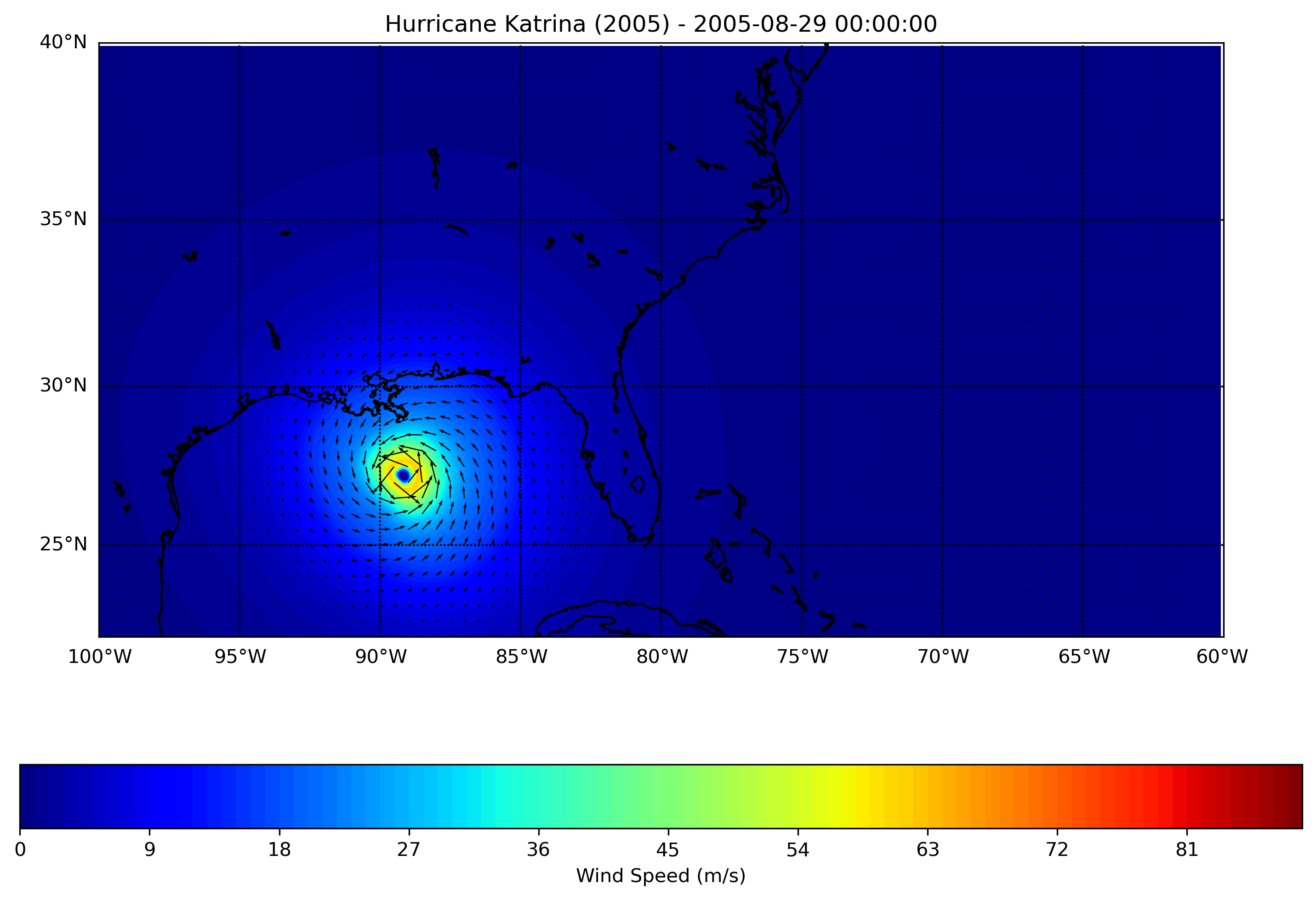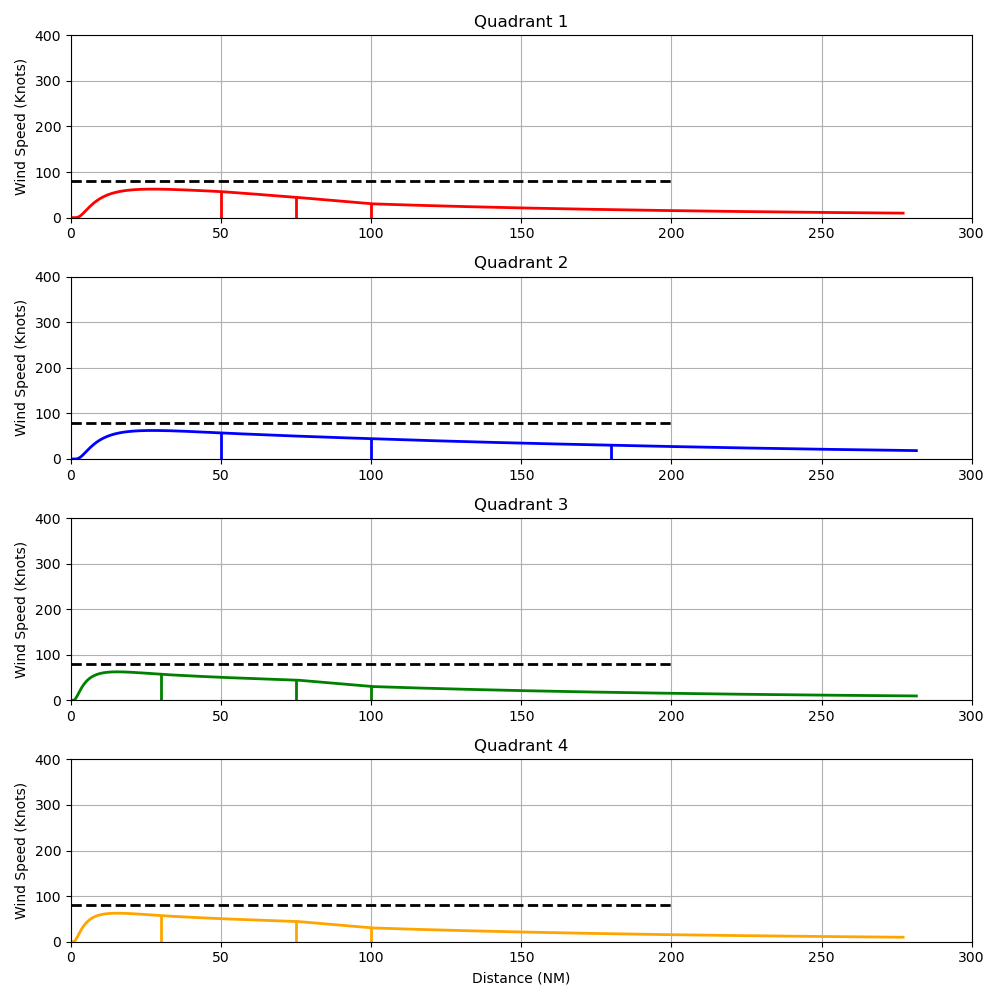The GAHM model uses hurricane parameters in ATCF format to construct a hurricane vortex for use in storm surge modeling or other analysis.
The project reimplements the GAHM model originally developed by Gao et al. and included in the ADCIRC model. The reimplementation allows users to run the GAHM model without ADCIRC and through a C++, Fortran, or Python interface.
The project is under active development but is not considered production ready.
Below is an example of the GAHM model output for Hurricane Katrina. This image was generated
using the Python interface to the GAHM model and the example script in examples/ex1_katrina.py using the following
command:
./ex1_katrina.py --type wind ../tests/test_files/bal122005.dat \
--time 2005-08-29 --output katrina.png
You can also view the expected result whereby the wind profile exactly matches the specified isotachs using the second example script in the examples directory.
In addition to a Python interface, there is also a Fortran interface. The Fortran interface is intended for use by the ADCIRC model, so its scope may be somewhat limited. This may change based on feedback. As a general rule, the Python interface is preferred for general tinkering and the C++ interface is preferred for performance. The Fortran interface is available for narrow use cases.
A quick comparison of the interfaces is shown below. The Python interface and C++ interface are nearly identical because they are generated via SWIG. The Fortran interface is wrapped by hand and care needs to be taken with ensuring safe memory management when moving between languages.
#include <iostream>
#include "atcf/AtcfFile.h"
#include "datatypes/WindGrid.h"
#include "preprocessor/Preprocessor.h"
#include "vortex/Vortex.h"
int main(int argc, char** argv) {
//...Generate a wind grid. A wind grid is useful for generating a
// domain for interpolation, however, any arrangement of points can
// be used. The user only needs to generate a PointCloud object and
// pass that to the Vortex object.
Gahm::Datatypes::WindGrid wg = Gahm::Datatypes::WindGrid::fromCorners(
-100.0, 22.0, -78.0, 32.0, 0.1, 0.1);
//...Read the ATCF file. Note that this is a RAW atcf file, not an ADCIRC
// formatted NWS=XX file
const std::string filename = "test_files/bal122005.dat";
auto atcf = Gahm::Atcf::AtcfFile(filename);
atcf.read();
//...Run the preprocessor. This is the equivalent of the ADCIRCs ASWIP program
// This solves for the GAHM model parameters for use by the Vortex object
Gahm::Preprocessor prep(&atcf);
prep.solve();
//...Create the Vortex object using the PointCloud object and the AtcfFile object
auto v = Gahm::Vortex(&atcf, wg.points());
//...Solve the vortex at the given time
auto time = Gahm::Datatypes::Date(2005, 8, 29, 0, 0, 0);
auto solution = v.solve(time);
//...Write the solution to the screen
std::cout << solution.uvp()[42].u() << ", "
<< solution.uvp()[42].v() << ", "
<< solution.uvp()[42].p() << std::endl;
}import pygahm
import numpy as np
filename = "test_files/bal122005.dat"
# Generate the wind grid
wind_grid = pygahm.WindGrid.fromCorners(-100.0, 22.0, -60.0, 40.0, 0.1, 0.1)
# Read the ATCF file
atcf = pygahm.AtcfFile(filename)
atcf.read()
# Run the preprocessor
prep = pygahm.Preprocessor(atcf)
prep.solve()
# Create the Vortex object
v = pygahm.Vortex(atcf, wind_grid.points())
# Solve the vortex at the given time
time = pygahm.Date(2005, 8, 29, 0, 0, 0) #...NOT a python datetime object
# Solve the vortex
solution = v.solve(time)
# Print the solution
u = np.array(solution.u())
v = np.array(solution.v())
p = np.array(solution.p())
print(u[42], v[42], p[42])subroutine gahm_test()
use gahm_module
implicit none
type(gahm_t) :: gahm
type(date_t) :: current_date
character(200) :: filename
integer(8) :: n_pts
real(8) :: x(1), y(1)
real(8) :: u(1), v(1), p(1)
x(1) = -90.0
y(1) = 29.0
n_pts = size(x)
filename = "tests/test_files/bal122005.dat"
call gahm%initialize(filename, n_pts, x, y)
call current_date%set(2005,8,27)
call gahm%get(current_date, n_pts, u, v, p)
end subroutine gahm_testNote that the Fortran interface will manage the memory for the GAHM objects automatically using C++ std::unique_ptr types.
Still, though, depending on the compiler, the user should place gahm_t objects within subroutines to ensure that
the destructor is called explicitly as Fortran's behavior isn't as well defined as other OOP languages.
The project is built using CMake.
The following dependencies are required to build the project:
- CMake (3.18 or greater)
- C++ compiler (with C++17 compatibility, i.e. gcc 7.0 or greater)
The following are optional dependencies:
- Python 3
- SWIG 4.0+ (Python interface)
- Fortran compiler (Fortran interface)
- Clang/LLVM (Fuzz testing)
In its most simple form, the project can be built on the command line using:
mkdir build
cd build
cmake ..
make
In the case that you'd like to see more sophisticated examples, the .github/workflows directory contains a number of examples of how to build the project for various use cases.

